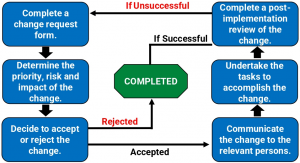
This change management procedure can assist your business comply with AS/NZS ISO 9001, Quality Management Systems clauses:
A change management procedure is a formal process that has been designed around the AS/NZS ISO 9001 standard. It can be used to ensure that any changes made to a company’s processes, products, or services are properly documented and approved.
When followed the procedure will also prevent unplanned or unauthorized changes from being made, which could potentially lead to problems or disruptions in the company’s operations.
Change management as it relates to AS/NZS ISO 9001 is a process that helps ensure changes to a product, service or system are introduced in a controlled and systematic way. It helps to ensure that changes are properly planned, tracked and implemented and that the impacts of those changes are understood and controlled to achieve the benefits desired.
Change management is an important part of any AS/NZS ISO 9001 quality management system (QMS) and is especially critical in environments where products or services are highly regulated or there is a need to meet stringent quality assurance standards or particular customer requirements.
The change management approval process is the sequence of steps or activities that a company uses to introduce meaningful changes to its products, services, or processes. Change management processes will follow the general steps outlined below. Each step within this process may be detailed in change request documentation, to clarify the change. If needed.
Upon identifying and considering a change (proactive or reactive), a change request must be assessed by the controlling person, to determine the nature of the change, e.g. emergency, major, minor or if further information is required.

Change Management Flowchart
Depending on the nature of the change or potential impact it may need to be recorded on an approval form and put forward to management or other interested parties for review and approval.
The applicable person or manager will review the change request and will either:
If approved the change implementer(s) will communicate the proposed change to the relevant persons. If not approved the reasons why need to be communicated to the impacted persons.
The change implementer(s) will then undertake the tasks to accomplish the change within the designated time frames.
A post-implementation review should then be undertaken to assess whether the change was successful or if it requires further modification. This review can also include any customer feedback on potential risks and opportunities.
Note: If necessary, training should be given to all persons that participate in any new work or operational processes. Management should also retain all documented information related to the change and any continual improvement data for auditing purposes.
